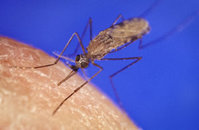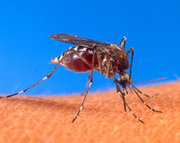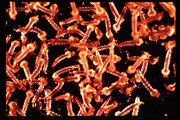Mosquito
The mosquito is a member of the family Culicidae; these insects have a pair of scaled wings, a pair of halteres, a slender body, and long legs. more...
The females of most mosquito species suck blood from other animals. Size varies but is rarely greater than 15 mm (0.6 inch). Mosquitoes weigh only about 2 to 2.5 mg (0.03 to 0.04 grain). They can fly at about 1.5 to 2.5 km/h (0.9 to 1.6 mph) and most species are nocturnal.
Mosquitoes are believed to have evolved around 170 million years ago during the Jurassic era (206–135 million years ago) with the earliest known fossils from the Cretaceous era (144–65 million years ago). They evolved in the land mass that is now South America, spreading initially to the northern continent Laurasia and re-entering the tropics from the north. Ancestral mosquitoes were about three times the size of the extant species and they are a sister group to the Chaoboridae (biting midges).
The family Culicidae belongs to the order Diptera and contains about 3500 species in three subfamilies: Anophelinae (3 genera), the Culicinae (9 genera and >80% of all the species) and the Toxorhynchitinae (1 genus). The genera include Anopheles, Culex, Psorophora, Ochlerotatus, Aedes, Sabethes, Wyeomyia, Culiseta, and Haemagoggus. Within the family Anophelinae six subgenera are recognized: Stethomyia, Lophopodomyia, Kerteszia, Nyssorhynchus (all South American), Cellia (Old World only) and Anopheles (worldwide).
Mosquitos are principally nectar feeders with only the females requiring a meal of blood. In contrast to this rule the Toxorhynchites never drinks blood. This family includes the largest of the extant mosquitoes (colloquially referred to as "mosquito eaters") and their larvae are predatory on the larvae of other mosquitoes. Attempts have been made in the past to use these as mosquito control agents but with variable success.
Mosquito is a Spanish word meaning "little fly", with its use dates back to about 1583. Before then, they were called "biting flies" in English, but the term "mosquito" was adopted to prevent confusion with the house fly. The word derives from Sanskrit maksh (fly) via the Latin word musca (fly) and the Italian moschetta or Spanish mosquito (little fly). The French word is moustique.
The female mosquito (in almost all species) sucks the blood of mammals, including humans — commonly referred to (incorrectly) as a "bite." Mosquito bites often swell up hours after happening, causing a red ringed white bump about a centimeter in diameter. This bump can itch for days and over-scratching the bite can cause it to bleed. Mosquito bites can transmit diseases, such as malaria and West Nile Virus, so authorities in many areas take measures to reduce mosquito populations through pesticides or more organic means. An easy way to reduce mosquito populations in a residential area is the removal of standing water (where mosquitoes breed), and the use of repellents, such as DEET.
Natural history
In most female mosquitoes, the mouth parts form a long proboscis for piercing the skin of mammals (or in some cases birds or even reptiles and amphibians) to suck their blood. As opposed to a syringe's typically smooth needle, the mosquito proboscis is highly serrated, which leaves a minimal number of points of contact with the skin being pierced — this reduces nerve stimulation to the point where the "bite" is not felt at all, which is generally the case (see the Mosquitoes and health section below for an explanation on the swelling.) The females require protein for egg development, and since the normal mosquito diet consists of nectar and fruit juice, which has no protein, most must drink blood to get the necessary protein. Males differ from females, with mouth parts not suitable for blood sucking.
The mosquito undergoes complete metamorphosis, going through four distinct stages in its life cycle: egg, larva, pupa, and adult — a process that was first described by the Greek philosopher Aristotle. The length of the first three stages is dependent on the species and temperature. Culex tarsalis may complete its life cycle in 14 days at 20 °C (68 °F) and only ten days at 25 °C (77 °F). Some species have a life cycle of as little as four days or up to one month. The larvae are the "wrigglers" or "wigglers" found in puddles or water-filled containers. These breathe atmospheric oxygen through a siphon at the tail end. The pupae are nearly as active as the larvae, but breathe through thoracic "horns" attached to the thoracic spiracles. Most larvae feed on microorganisms, but a few are predatory on other mosquito larvae. Some mosquito larvae, such as those of Wyeomyia live in unusual situations. These mosquito wigglers live either in the water collected in epiphytic bromeliads or inside water stored in carnivorous pitcher plants. Larvae of the genus Deinocerites live in crab holes along the edge of the ocean.
Most mosquito species outside of the tropics overwinter as eggs, but a significant minority overwinter as larvae or adults. Mosquitoes of the genus Culex (a vector for St. Louis encephalitis) overwinter as mated adult females.
The females of blood sucking species locate their victims primarily through scent. They are extremely sensitive to the carbon dioxide in exhaled breath, as well as several substances found in sweat. Some people seem to attract mosquitoes more than others. Empirical studies of mosquito bites suggest that the risk of being bitten follows an approximately negative binomial distribution. Being male, being overweight, and having type 'O' blood may increase the risk of being bitten. Mosquitoes can detect heat, so they can find warm-blooded mammals and birds very easily once they get close enough.
Mosquitoes and health
In the United States, mosquito bites are mostly a nuisance. However, worldwide, mosquitoes are a major public health problem; they are estimated to transmit disease to more than 700 million annually, and will be responsible for the deaths of about one in 17 people currently alive.
Read more at Wikipedia.org



